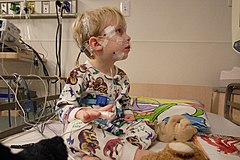Pediatrics (also spelled
paediatrics in the United Kingdom and Commonwealth) is the branch of medicine that deals with the medical care of infants, children, and adolescents. The upper age limit ranges from age 14 to 18, depending on the country.
A medical practitioner who specializes in this area is known as a pediatrician (also spelled paediatrician).
The word pediatrics and its cognates mean healer of children; they derive from two Greek words: παῖς (pais = child) and ιατρός (iatros = doctor or healer).

Pediatric polysomnography patient
Children's Hospital (Saint Louis), 2006
Differences between adult and pediatric medicine
Pediatrics differs from adult medicine in many respects. The obvious body size differences are paralleled by maturational changes. The smaller body of an infant or neonate is substantially different physiologically from that of an adult. Congenital defects, genetic variance, and developmental issues are of greater concern to pediatricians than they often are to adult physicians. Childhood is the period of greatest growth, development and maturation of the various organ systems in the body. Years of training and experience (above and beyond basic medical training) goes into recognizing the difference between normal variants and what is actually pathological.
Treating a child is not like treating a miniature adult. A major difference between pediatrics and adult medicine is that children are minors and, in most jurisdictions, cannot make decisions for themselves. The issues of guardianship, privacy, legal responsibility and informed consent must always be considered in every pediatric procedure. In a sense, pediatricians often have to treat the parents and sometimes, the family, rather than just the child. Adolescents are in their own legal class, having rights to their own health care decisions in certain circumstances only, though this is in legal flux and varies by region.
History of pediatrics
In the 9th century, the famous Persian physician Rhazes (Muhammad ibn Zakarīya Rāzi) wrote The Diseases of Children, the first book to deal with pediatrics as an independent field of medicine. For this reason, some medical historians consider him the father of pediatrics. His teacher Ali ibn Sahl Rabban al-Tabari was also a pioneer in the field of child development, which he earlier discussed in his Firdous al-Hikmah. The first work on pediatrics in the Western world was the Book of Children, written circa 1530 by Thomas Phaer, who was inspired by the works of Rhazes and Avicenna.
Pediatrics as a separate area of medical practice in the Western world largely began in the nineteenth century The Hospital for Sick Children, Great Ormond Street (London) was founded in 1852, and is probably the oldest such children's hospital in the English-speaking world. Great Ormond Street is adjacent to Coram's Fields, the site of the much earlier Foundling Hospital. The emigrant German physician, Abraham Jacobi, worked in the same period and is often considered the father of pediatrics.
Training of pediatricians
The training of pediatricians varies considerably across the world.
Like other medical practitioners, pediatricians begin their training with an entry-level medical education: a tertiary-level course, undertaken at a medical school attached to a university. Such a course leads to a medical degree.
Depending on jurisdiction and university, a medical degree course may be either undergraduate-entry or graduate-entry. The former commonly takes five or six years, and has been usual in the Commonwealth. Entrants to graduate-entry courses (as in the USA), usually lasting four or five years, have previously completed a three- or four-year university degree, commonly but by no means always in sciences. Medical graduates hold a degree specific to the country and university in and from which they graduated. This degree qualifies that medical practitioner to become licensed or registered under the laws of that particular country, and sometimes of several countries, subject to requirements for "internship" or "conditional registration".
Within the United States, the term physician also describes holders of the Doctor of Osteopathic medicine (D.O.) degree. For further information on osteopathic medicine, see the entry on the comparison of MD and DO in the US.
Pediatricians must undertake further training in their chosen field. This may take from three to six or more years, depending on jurisdiction and the degree of specialization. The post-graduate training for a primary care physician, including primary care pediatricians, is generally not as lengthy as for a hospital-basedmedical specialist.
In most jurisdictions, entry-level degrees are common to all branches of the medical profession, but in some jurisdictions, specialization in pediatrics may begin before completion of this degree. In some jurisdictions, pediatric training is begun immediately following completion of entry-level training. In other jurisdictions, junior medical doctors must undertake generalist (unstreamed) training for a number of years before commencing pediatric (or any other) specialization. Specialist training is often largely under the control of pediatric organizations (see below) rather than universities, with varying degrees of government input, depending on jurisdiction.
"Pediatrician" versus "Paediatrician"
A slight semantic difference has developed in association with the difference in spelling. In the USA, a pediatrician (US spelling) is a specialist physician who generally functions in a primary care setting for children. Like all physicians, they first receive a general medical degree (from a US medical school, typically MD or DO). Next, such pediatricians (US spelling) complete an internship in pediatrics and then 2 additional years of residency in pediatrics. A similar situation exists in Germany: a Kinderarzt is commonly a primary care pediatrician.
In the UK and many other parts of the world, a paediatrician is also a specialist physician for children, but generally not in primary care. He or she sees children who are either urgently taken to a hospital or who are referred by general practitioners; the latter see the bulk of child patients in primary care. Such paediatricians (British spelling) generally first receive a general medical degree, typically MB BS, MB BChir etc, and then complete at least 2 years' general clinical training ("foundation training"), followed by 6 or more years' additional training in paediatrics or its subspecialties.
Subspecialists in pediatrics
Specialist pediatricians may undergo further training in sub-specialties. Practicing a subspecialty in pediatrics is similar in some respects to practising the relevant adult specialty, but a major difference is in the pattern of disease. Typically, diseases commonly seen in children are rare in adults (eg bronchiolitis, rotavirus infection), and those seen in adults are rare in children (eg coronary artery disease, deep vein thrombosis). Hence, pediatric cardiologists deal with the heart conditions of children, particularly congenital heart defects, and pediatric oncologists most often treat types of cancer that are relatively common in children (eg certain leukemias, lymphomas and sarcomas), but which are rarely seen in adults. Every subspecialty of adult medicine exists in pediatrics (with the obvious exception of geriatrics).
Adolescent medicine is a growing sub-specialty. The pattern of diseases in adolescents in part resembles that seen in older adults, and specialists or sub-specialists in adolescent medicine are also drawn from practitioners of internal medicine or family medicine. Another major sub-specialty, which is unique to pediatrics, is neonatology: the medical care of newborn babies.
Pediatric organizations
Most pediatricians are members of a national body. Examples are the American Academy of Pediatrics, the Canadian Paediatric Society, the Royal College Of Paediatrics and Child Health, Norsk barnelegeforening (The Norwegian society of pediatricians) or the Indian Academy of Pediatrics. In Australia and New Zealand, paediatricians are fellows of the Royal Australasian College of Physicians, which covers both nations and which has adult & paediatric sections. This was the situation in the UK until the late 1990s, where specialist pediatricians were Members Fellows of either the Royal College of Physicians or of the fraternal colleges in Scotland. In 1996, British paediatricians were granted a royal charter to form their own college, the Royal College of Paediatrics and Child Health.CNS Ayurveda Chikitsalayam - World's first ISO Certified Ayurveda Pediatric Hospital.
Social role of pediatric specialists
Like other medical practitioners, pediatricians are traditionally considered to be members of a learned profession, because of the extensive training requirements, and also because of the occupation's special ethical and legal duties.
Pediatricians commonly enjoy high social status, often combined with expectations of a high and stable income and job security. However, medical practitioners in general often work long and inflexible hours, with shifts at unsociable times, and may earn less than other professionals whose education is of comparable length. Neonatologists or general pediatricians in hospital practice are often on call at unsociable times for perinatal problems in particular — such as for Cesarean section or other high risk births, and for the care of ill newborn infants.
In August 2000, during a "name and shame" campaign by Rupert Murdoch's News of the World, a paediatrician in Wales had her home and car vandalised by "vigilantes", who believed "paediatrician" meant "paedophile".







